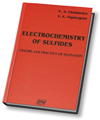Electrochemistry of sulfides. Theory and practice of flotation

V. A. Chanturiya, V. E. Vigdergauz
The development and results of electrochemical studies in the field of sulfide flotation are discussed and generalized. The role of oxygen and redox transitions on the sulfide surface in the kinetics of sorption of thiol collectors and the formation of hydrophobic layer on the surface of sulfide minerals is shown. The regularities of autooxidation of thiols catalyzed by cobalt phthalocyanines are described. The effect of inhomogeneity of mineral surface on the wettability of minerals is considered. Theoretical aspects and practical potentialities for enhancing the contrast of physicochemical and flotation properties of sulfides and the reagentless methods for optimization of flotation of polymetallic and gold-bearing sulfide ores are considered. The monograph is intended for the researchers and engineers engaged in the flotation and hydrometallurgy.
ISBN: 978-5-98191-047-6
Страницы: 280
Переплет: твердый
Издатель: ИД "Руда и Металлы"
Язык: Russian
Год издания: 2009
Информацию о наличии издания и его цену можно узнать по эл. почте books@rudmet.ru.
Contents:
Preface
Designations and Abbreviations
Introduction
CHAPTER 1. Historical Data
1.1. First Publications
1.2. Electrochemical Properties of Sulfides and Flotation
1.3. Electrolysis of Mineral Suspensions
CHAPTER 2. Physical Properties of Sulfide Minerals
2.1. Stoichiometry and Character of Bonds; Structure
2.2. Electronic Characteristics
2.3. Semiconductor-Solution Interface: the Electrokinetic Properties
2.3.1. Electrostatic repulsion energy
2.4. Morphology of Ores and Selective Recovery of Minerals
CHAPTER 3. Redox Transitions of Sulfides
3.1. Thermodynamics of Reactions
3.2. Potentiometric Measurements
3.3. Cyclic Voltammetry
3.4. Rotating Disk Electrode
3.5. Iron Sulfides
3.6. Arsenopyrite
3.7. Copper Sulfides
3.8. Nickel Sulfides
3.9. Molybdenite
3.10. Zinc Sulfides
3.11. Galena
CHAPTER 4. Problem of Oxygen
4.1. Cathodic Reaction in Sulfide Flotation
4.2. Oxygen Electroreduction
4.3. Activity Series
4.4. Galvanic Effect
CHAPTER 5. Oxidation of Xanthates
5.1. Thermodynamics and Possible Products
5.2. Chemical Oxidation
5.3. Electrooxidation
5.4. Catalysis
5.5. Catalytic Autooxidation and Flotation
CHAPTER 6. Electrochemical Aspects of Collectors Sorption
6.1. Boundary Stability Potentials
6.2. The Effect of Electrochemical Polarization
CHAPTER 7. The Wettability under Polarization
7.1. Crystallochemical Peculiarities of Water
7.2. The Wettability Measurements
7.3. Platinum Electrode
7.4. Pyrite, Pyrrhotite, and Arsenopyrite
7.5. Chalcopyrite, Bornite, and Chalcocite
7.6. Galena
7.7. Molybdenite
7.8. Sphalerite
7.9. Enhancement of Wettability Contrast for Sulfide Minerals
7.10. Nanoheterogeneity of Wetting Film
CHAPTER 8. Sulfide Flotation as a Potential-Controlled Process
8.1. Oxidants and Reductants
8.2. Reagent Modes of Sulfide Flotation
8.2.1. Oxidation modes
8.2.2. Reduction modes
8.2.3. Combined modes
8.3. Separation of Gold-Bearing Sulfides
CHAPTER 9. Electrochemical Control of Flotation Conditions
9.1. Suspension Electrodes
9.1.1. Theory
9.1.2. Experimental estimation of electrochemical charging
9.2. Electrochemical Treatment and Flotation of Minerals
9.2.1. Electrochemical treatment of mineral suspensions
9.2.2. Pyrite and arsenopyrite
9.2.3. Chalcopyrite
9.2.4. Galena
9.2.5. Molybdenite
9.3. Electrochemical Treatment of Pulp
9.3.1. Cells
9.3.2. Typical examples of electrochemical treatment used in flotation
9.3.2.1. Copper ores
9.3.2.2. Copper-zinc ores
9.3.2.3. Copper-arsenic mid-products
9.3.2.4. Copper-molybdenum concentrates
9.3.2.5. Copper-lead concentrates
9.3.2.6. Copper-nickel ores
9.3.3. General principles of electrochemical control of flotation conditions
References






